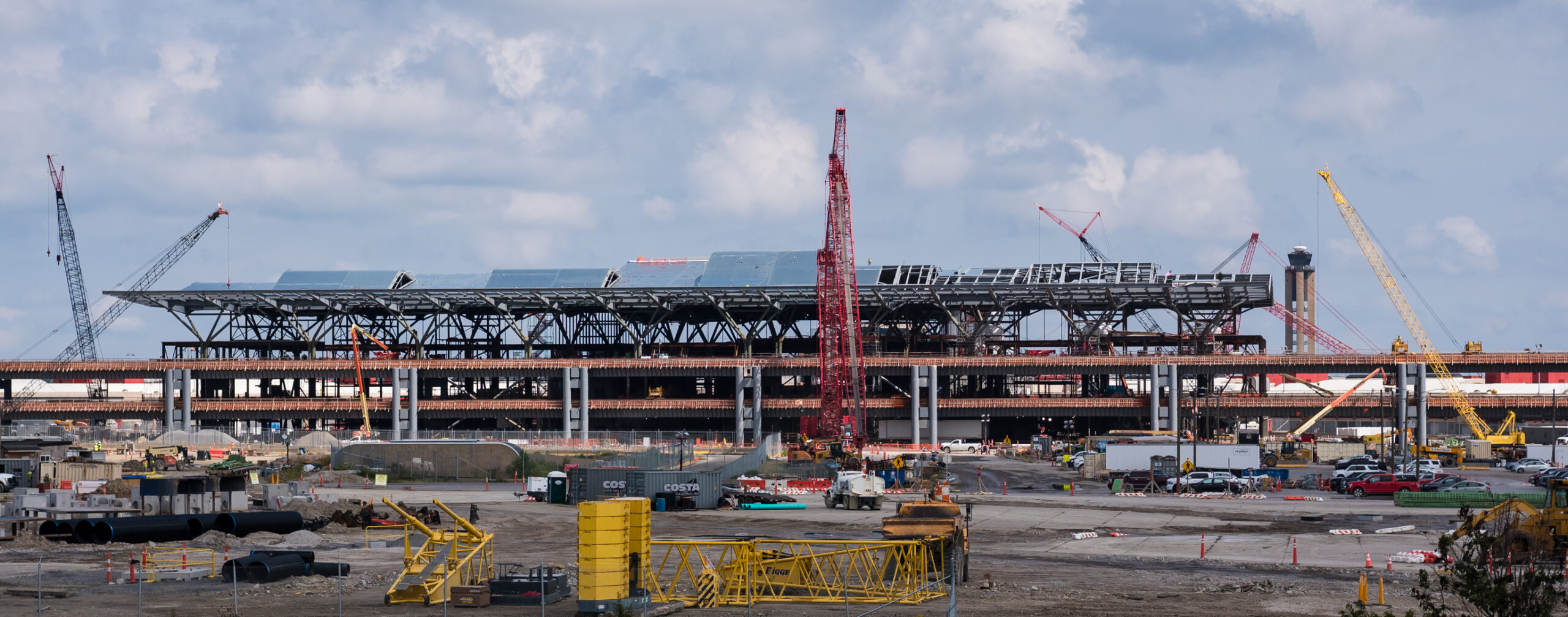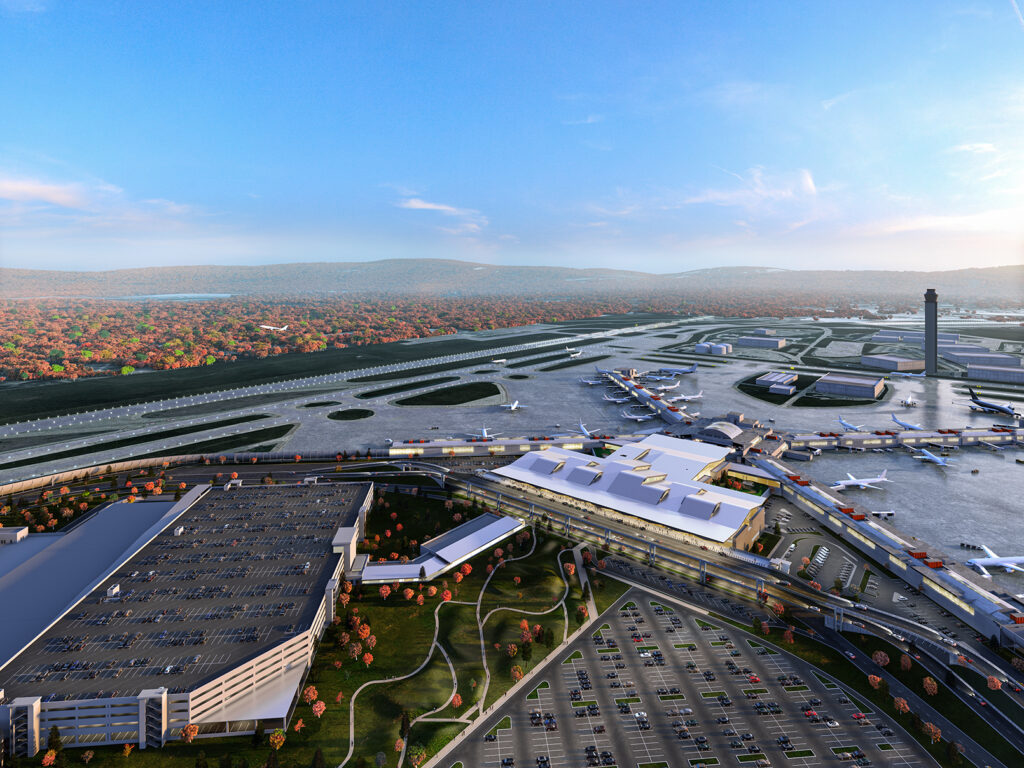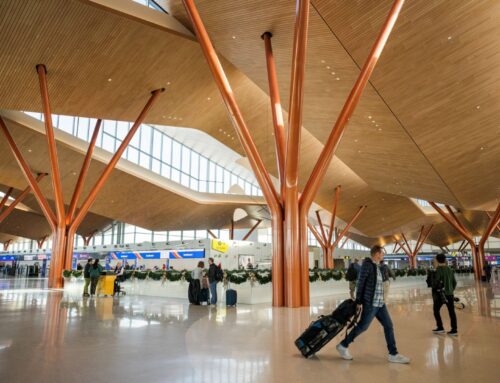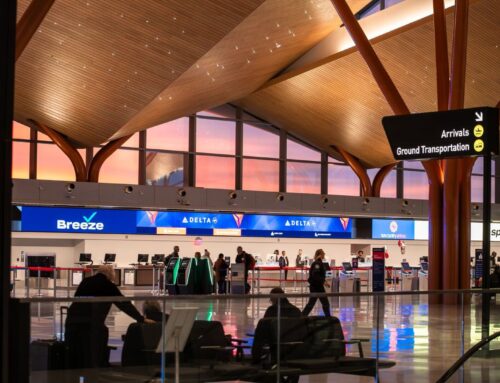New Terminal Construction Passes Halfway Mark
By Jonathan Potts
Published September 12, 2023
Read Time: 3 mins

Construction on the Terminal Modernization Program (TMP) at Pittsburgh International Airport passed the halfway point over the summer and remains on track for completion in 2025.
In recent weeks, workers on the TMP poured concrete for the roadway bridge that will carry traffic to and from the new landside terminal, completed the high roof steel, and began installation of the bridge that will connect the new terminal to the existing airside terminal.
“We are building the airport that Pittsburgh deserves and which will serve our families, friends and neighbors for generations to come,” said Christina Cassotis, CEO of the Allegheny County Airport Authority (ACAA), which operates PIT.
Airlines at PIT have unanimously approved a revised $1.57 billion budget for the TMP. The TMP is funded mostly through long-term bonds that the ACAA will pay back from its operating revenue, most of which is paid by the airlines through rates and charges.
No local or state tax dollars are being used to pay for the project, which has been awarded $23.5 million in federal grants under the Bipartisan Infrastructure Law. The law includes funding for national critical infrastructure, such as airports.
“Thanks to the partnership we have built with the airlines, air service at PIT has continued to grow, which is a big boost to the Pittsburgh region,” Cassotis said. “We are grateful for the airlines’ unwavering faith in our vision for the new Pittsburgh International Airport.”

PIT’s new 1.14 million square-foot parking garage will consist of five levels and 4,200 spaces, adding parking and reducing walking distances for passengers. (Rendering courtesy of Gensler + HDR in association with luis vidal + architects)
The ACAA had previously pegged the cost of the TMP at $1.4 billion but revised it up to account for pandemic-related inflation and supply-chain shortages. The ACAA started to bid for supplies and services in 2020 and 2021, during the midst of the Covid-19 pandemic, when material and labor costs were skyrocketing. Cost increases on the TMP have nonetheless remained well below that of other building projects in the Pittsburgh region. Locally, construction costs have increased approximately 30 percent since 2019, according to the Engineering News-Record Construction Cost Index.
Nearly all bids on the TMP have netted out to within 1 percent of the ACAA’s original estimates, but costs have climbed in four key areas:
- Interiors, which includes flooring, paint, other finishes, and walls;
- Integrator package, which includes technology such as servers, flight information display boards, digital screens and fiber optic cables;
- Roadways, which includes the cost of concrete and rebar, among other materials; and
- Structural steel, which impacts nearly every aspect of the project.
“The TMP is far from the only airport construction project impacted by price volatility,” said TMP Program Director Perfecto Solis, a principal with Paslay Group, which provides executive program management and other consulting services for airports across the U.S. “From LAX to Miami, there is a rightsizing of capital project budgets under way.”
Suited to passenger needs
The TMP includes a new landside terminal, parking garage, and roadway system. Construction started in October 2021. Benefits of the project will include:
- Shorter passenger walk and wait times
- Reduced baggage delivery times
- 6,000 additional public parking spaces
- More efficient international arrivals process
- Significant reduction in operations and maintenance costs
PIT opened in its current configuration in 1992, when Pittsburgh was a hub for the now defunct U.S. Airways. The airport was built to the airline’s specifications and primarily served passengers connecting to and from other airports. But in 2004, having filed for bankruptcy twice in two years, U.S. Airways dropped Pittsburgh as a hub.
By 2014, nonstop service had dwindled to just 37 destinations. Cassotis was hired as CEO the following year, and nonstop service has climbed to 61 airports with 151 peak-day departures since then.
PIT is now an origin-and-destination airport with most passengers beginning and ending their trip in Pittsburgh.
“The new terminal will be suited to their needs,” said Paul Hoback, ACAA Executive Vice President and Chief Development Officer. It is also projected to save ACAA a significant amount of operational and maintenance costs annually.
“We are building this new terminal for Pittsburgh and by Pittsburgh to connect to the world,” said Hoback.






